MIO - less invasive stabilization system (LISS)
1. Principles
LISS fixation
The LISS plate is an internal fixator used as an extramedullary splint, fixed to the two main fragments, leaving the intermediate fracture zone untouched. Anatomical reduction of intermediate fragments is neither sought nor necessary.
Direct manipulation of intermediate fragments would risk disturbing their blood supply. If the soft-tissue attachments to these fragments are preserved, and the fragments are generally aligned, healing is unimpaired.
Any fractures of the articular block needs to addressed first under direct vision using standard techniques of interfragmentary compression. Alignment of the main shaft fragments can then be achieved indirectly, using various aids before application of the plate.
The LISS plate is commonly inserted using minimally invasive techniques, leaving the soft tissues intact around the fracture site. Incisions are made proximally and distally, and the LISS plate is inserted into a submuscular tunnel. This normally requires image intensifier monitoring.
Mechanical stability is adequate for gentle functional rehabilitation and results in satisfactory indirect healing (callus formation) of the diaphysis.
A common failure of the LISS is seen when a simple plane fracture is treated with the relatively flexible LISS plate and left with a gap. This can result in a high rate of nonunion.
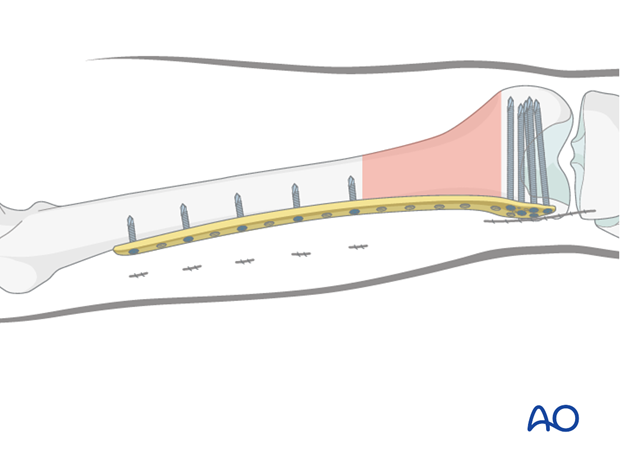
Teaching video
This video demonstrates the lateral parapatellar approach for the reduction and fixation of the articular block as well as the insertion of an LCP plate in a minimally invasive manner. The LISS plate is used.
This video demonstrates the application of a LISS plate to a 33C2 fracture in a minimally invasive manner.
Anatomy of the distal femur
The distal femur has a unique anatomical shape. Seen from an end-on view, the lateral surface has a 10° inclination from the vertical, while the medial surface has a 20–25° slope.
A line is drawn from the anterior aspect of the lateral femoral condyle to the anterior aspect of the medial femoral condyle (patellofemoral inclination) that slopes approximately 10°. These anatomical details are important when inserting screws. In order to avoid joint penetration, these devices should be placed parallel to both the patellofemoral and femorotibial joints planes.
The muscle attachments to the distal femur are responsible for the typical displacement of the distal articular block following a supracondylar fracture, namely shortening with varus and extension deformity. Shortening is due to the pull of the quadriceps and hamstring muscles, while the varus and extension deformity is caused by the unopposed pull of the adductors and gastrocnemius, respectively.
The popliteal vessels, the tibial nerve, and the common peroneal nerve lie near the posterior aspect of the distal femur. Because of this, vascular injuries occur in about 3% and nerve injuries in about 1% of fractures of the distal femur.
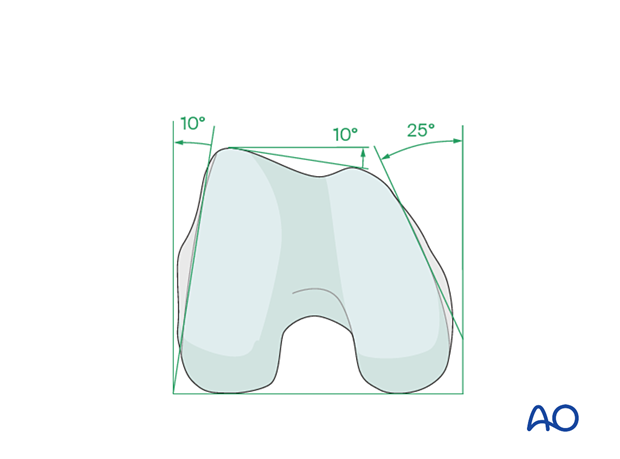
There are no significant arteries, veins, or nerves on the lateral side of the knee.
There may be bleeding from the lateral genicular arteries, which will need to be controlled using diathermy.
At the posterior aspect of the knee lie the popliteal artery, nerve, and vein. It must be borne in mind that these structures can be damaged by the injury or can be damaged by the surgeon during the reconstruction.
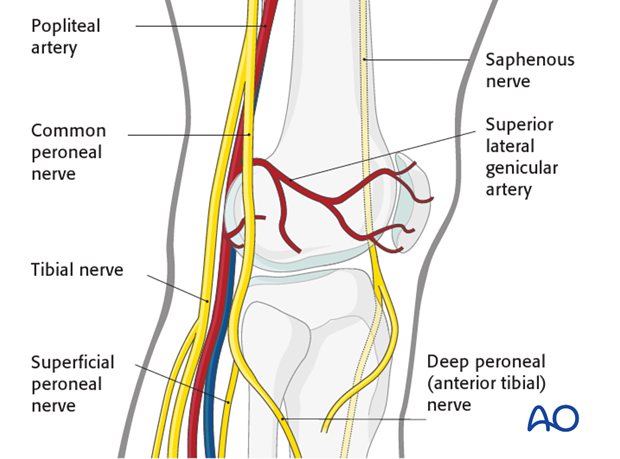
2. Choice of implant
LISS plate length
Generally, plates for the bridging technique should be longer than for conventional open plating techniques, in order to distribute the forces and to provide relative stability.
The preoperative x-ray planning template is useful in determining the length of the LISS plate and the positions of the screws.

Number of screws
In healthy bone, four well placed monocortical screws are inserted to secure the LISS to the main femoral shaft fragment.
The use of bicortical screws in severely osteoporotic bone may need to be considered.
3. Patient preparation and approach
Positioning
This procedure may be performed with the patient in one of the following positions:
- Supine position knee flexed 30°
- Supine position knee flexed 90°
- Lateral decubitus (particularly in obese patients)

Approach
For an extra-articular fracture, the minimally invasive lateral/anterolateral approach will suffice.
In an articular fracture, the chosen approach must adequately expose the articular surface of the distal femoral condyle.
In complete articular fractures with a simple articular component where the single articular fracture line is not medial to the midline, a minimally invasive lateral/anterolateral approach will usually permit an adequate view of the joint fracture reduction.

If the articular fracture is more medial, the lateral parapatellar approach will provide a better exposure of the joint reduction.
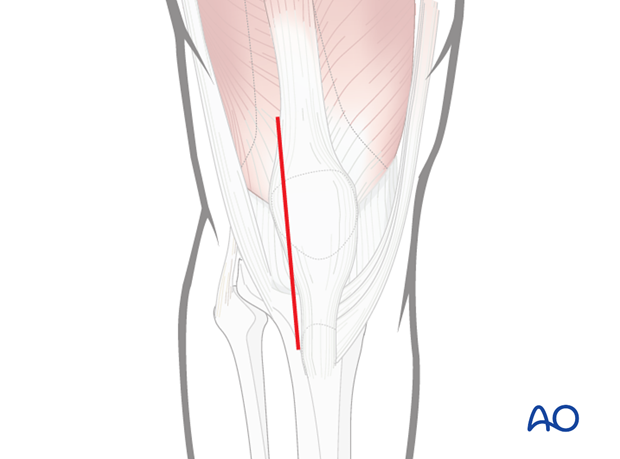
4. Reduction and fixation of the articular block
Reduction of the articular block
Reduction aids which are helpful include:
- A 5.0 mm or 6.0 mm Schanz pin in the medial and/or lateral femoral condyle to act as a joystick.
- Pointed reduction forceps, or large pelvic reduction clamps, to clamp from medial to lateral across the intercondylar split.
- Modified pointed reduction forceps on the medial or lateral aspect of the femoral condyles to help reduce frontal plane fractures (Hoffa fractures). The pointed reduction forceps are modified by straightening the curved tips. The straightened tips can then be placed in small 2.0/2.5 mm drill holes in the bone.
Attempts at a reduction of the intercondylar split with the pointed reduction forceps alone are often unsuccessful, as rotational control of the femoral condyle is also needed. The use of the Schanz pin in conjunction with the pointed reduction forceps is therefore preferred.
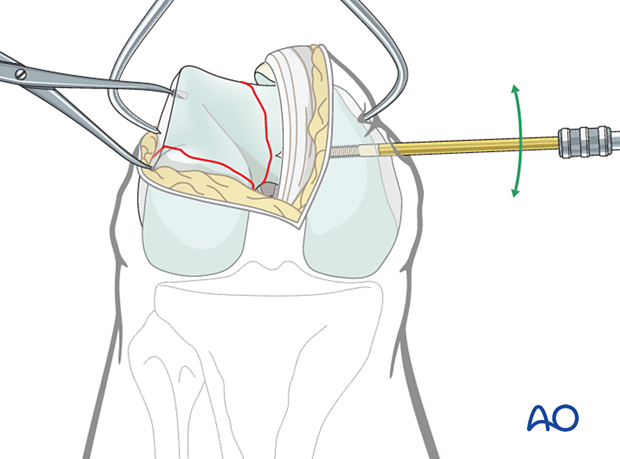
Provisional fixation
Before definitive fixation is undertaken, more than one forceps is applied. Usually, one to two additional K-wires are inserted, either from medial to lateral, or lateral to medial.
If the K-wires are inserted from medial to lateral, they may either go through small stab incisions in the skin or through the parapatellar retinaculum.
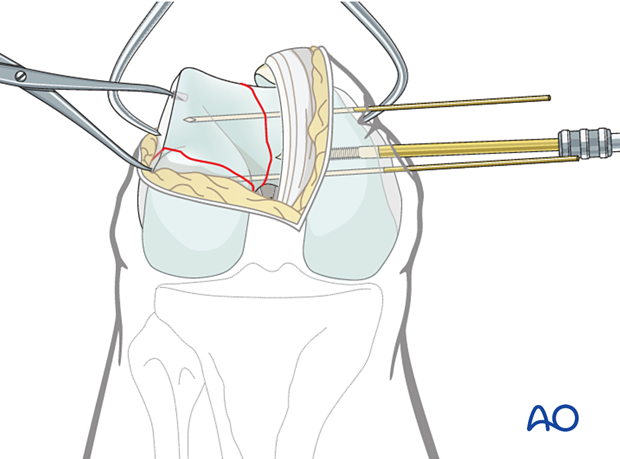
Definitive articular surface fixation
Definitive lag screws may then be inserted in the distal femoral articular block in several directions:
- Screws may be inserted along the periphery of the articular surface of the lateral femoral condyle going from lateral to medial to fix the intercondylar split.
- Screws may be inserted starting just proximal to the articular surface and aimed from anterior to posterior to fix the frontal plane fracture (Hoffa fracture). Buttress plating of the Hoffa fracture or posterior to anterior inserted screws is biomechanically superior.
- A diagonally inserted screw may be used in certain fracture patterns.
These screws may be fully threaded 2.7 or 3.5 mm lag screws (shown with gliding hole), 6.5mm partially threaded lag screws, or 4.0/4.5 mm cannulated partially threaded lag screws.
Insertion of screws in this manner leaves an area free of screw traffic or a „free zone“ of bone into which a laterally based plate system can be inserted (dotted circle). Insertion of screws in this manner allows a „free zone“ of bone into which the plate can be placed (dotted circle).
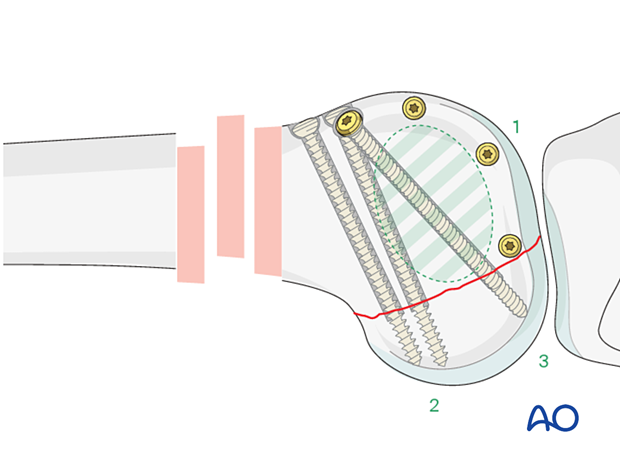
End-on view of the articular block fixation.

Multifragmentary articular fracture
Multifragmentary articular fractures may also be characterized with or without a Hoffa injury.
In this case, separate osteochondral fragments are ideally reduced and internally fixed by lag screws. However, in certain cases, the fragment may be either too damaged or too small to be reconstructed. In this case, if a fragment is removed, a position screw rather than a lag screw should be used to avoid over-compression of the articular surface.
In the case shown fragment A has been reduced into the appropriate position. This makes it possible to compress the articular surfaces with lag screws. However, fragment B was too damaged and too small to be accurately repositioned. A void is therefore left in the articular surface. In this situation, a fully threaded 3.5 mm standard screw (position screw) is then inserted between the condyles.
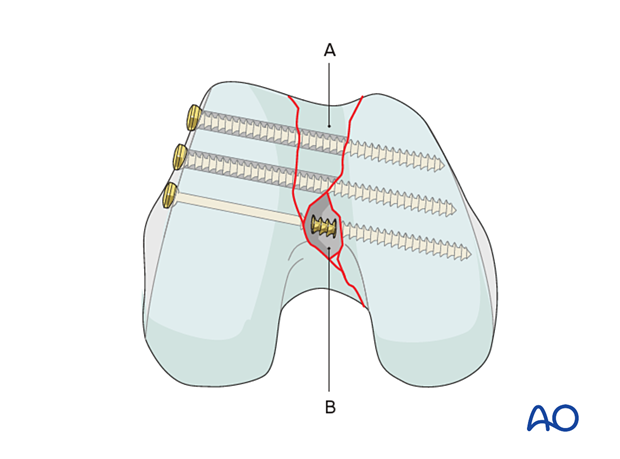
5. Reduction
Consideration must be given to fracture reduction in:
- Varus/valgus
- Flexion/extension
- Internal/external rotation
- Translation
- Lengthening/shortening
Reduction can be performed with a single reduction tool (eg, large distractor), or by combining several steps (for example fracture table +/- external fixator, +/- reduction via the implant, etc) to achieve the final reduction.
The preferred method depends on the fracture and soft-tissue injury pattern, the chosen stabilization device, and the experience and skills of the surgeon.
If a large fragment has separated from the fracture zone and impaled the adjacent muscle, direct reduction may be required.
Reduction aids
Closed reduction is aided by:
- Complete anesthetic muscle relaxation
- A bolster in the supracondylar region to reduce the hyperextension deformity of the distal femoral articular block.
- Manual traction
- Femoral distractor

Reduction can also be aided by:
- Use of Schanz pins inserted into the medial, or lateral, femoral articular block to correct varus or valgus angulation of the femoral block.
- Insertion of a Schanz pin from anterior to posterior in the distal femoral articular block, which can be used to correct hyperextension.
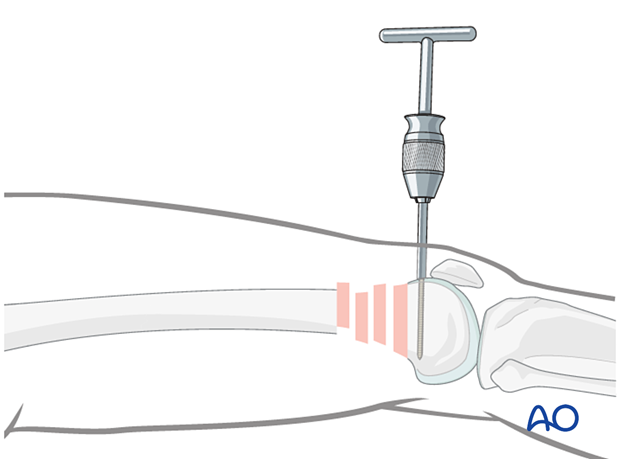
Use of external fixator/femoral distractor
Some surgeons find it useful to use an external fixator (or femoral distractor) from the proximal femur to the proximal tibia.
Due to the pull of the gastrocnemius muscle, the distal fragment tends to be displaced into extension at the metaphyseal fracture area, when distraction is applied.
To avoid this, the knee is brought into full extension, and the distal femoral fragment is stabilized in this position to the tibia. A Schanz screw is inserted in the distal femoral articular block and used to counter the pull of the gastrocnemius. When reduced, a temporary cerclage wire is used to lock the position of the Schanz screw relative to the distractor.
Insert the proximal and distal fixator (distractor) pins carefully in order not to conflict with the later plating procedure. Safe positions would be anterolateral or anterior on the femur.
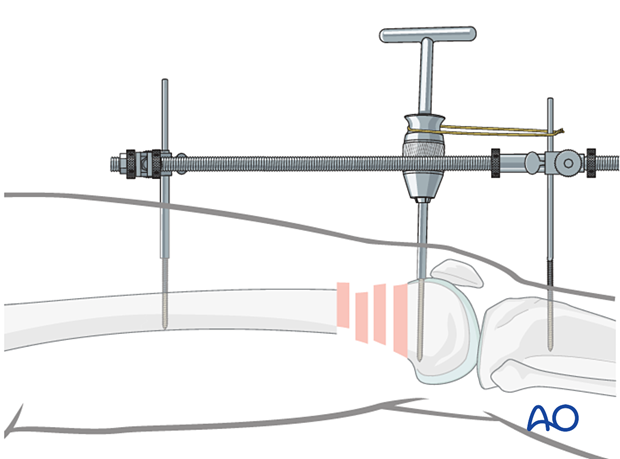
Verification of successful reduction
It is very important to restore the biomechanical axis of the lower limb. The normal biomechanical axis follows a line from the center of the femoral head, through the center of the proximal tibia and then through the center of the ankle joint. This axis can be checked intraoperatively by using a piece of cable, such as the diathermy cord. The cord is stretched from the iliac spine across the patella to the cleft between the first and second toes.
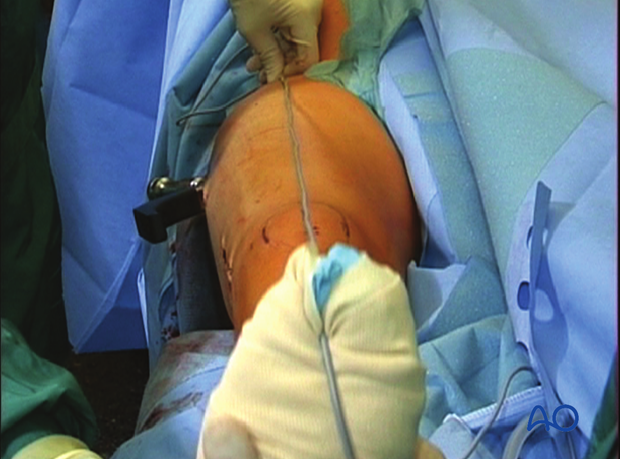
If rotation is correct, this cord will pass over the midline of the patella, and slightly medial to the tibial eminence. The radiological landmarks of the center of the femoral head, the center of the knee and the center of the ankle joint should all be in line if the mechanical axis of the femur is correct.
Another method of assessing rotational reduction is to compare the cortical thickness above and below the fracture. If a shaft fracture is multifragmentary, the image intensifier cannot be used to compare cortical diameters on each side of the fracture.
Not only must the biomechanical axis be restored, but care should be taken to ensure that there is no malrotation of the distal femur on the proximal femur.
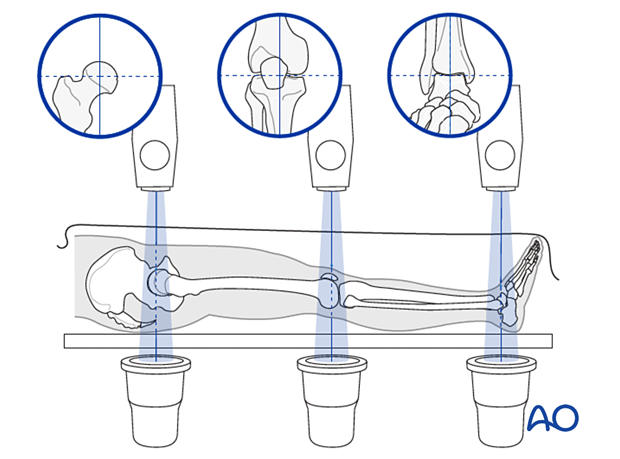
This illustration shows the longitudinal axes of the lower limb.
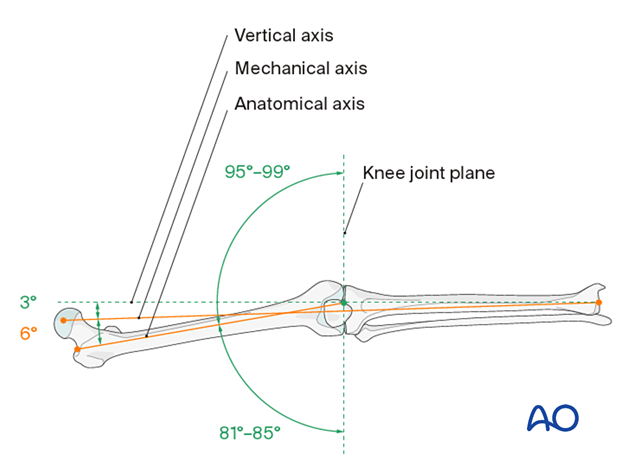
Confirmation of length
To ensure that femoral length has been restored, many options exist:
- One option involves reducing the fracture fragments anatomically, either directly or indirectly with fluoroscopic control.
- Even in multifragmentary fractures, there are usually a few main fracture segments that can assist the surgeon in ensuring that the appropriate length has been obtained.
- Another option involves taking radiographic images of the contralateral distal femur for comparison.
- A radiographic ruler can be used to measure the length of both femora. In this technique, it is important that the x-ray beams are perpendicular to the OR table and that the ruler is parallel to the OR table.

6. LISS plate insertion
Assembly of LISS insertion instruments
Connect the two parts of the insertion guide with the connection bolt. Now place the fixation bolt into hole “A”. Then, place the insertion guide onto the LISS, engaging the three-point locking mechanism.
Screw the fixation bolt into the LISS by turning the knurled head of the bolt and slightly tighten it using the pin wrench. Next, screw the nut of the fixation bolt clockwise and tighten it slightly with the pin wrench, to stabilize the attachment between the insertion guide and the LISS plate.
For more stable fixation of the LISS plate to the insertion guide during insertion, introduce a second stabilization bolt with the drill sleeve into hole “B” and thread it into the LISS plate.
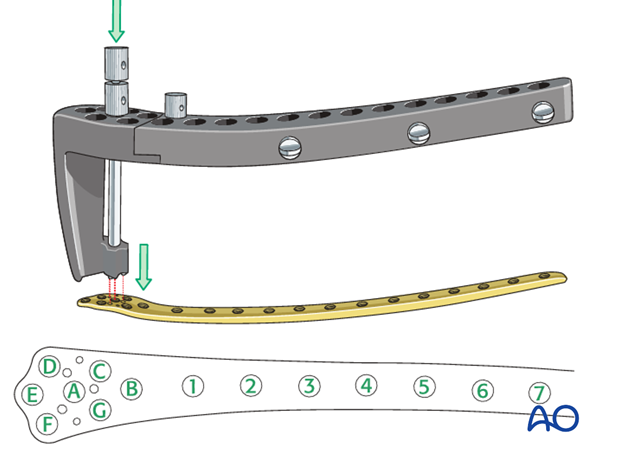
LISS plate insertion
Use the assembled insertion guide as a handle to insert the LISS plate into the submuscular tunnel between the vastus lateralis muscle and the periosteum.
Insert the LISS plate through the lateral incision.
Advance the LISS plate proximally under the vastus lateralis muscle, ensuring that its proximal end remains in constant contact with the bone. Position the distal end of the LISS plate against the lateral condyle. To identify the correct position, move the LISS plate proximally and then back distally until it fits the condylar contour.

Proper position check - position on the distal femur
When the LISS plate lies flat on the lateral surface of the condyle, it has been positioned correctly on the distal femur.
The plate is angled 10° posteriorly and must be firmly placed against the femur.
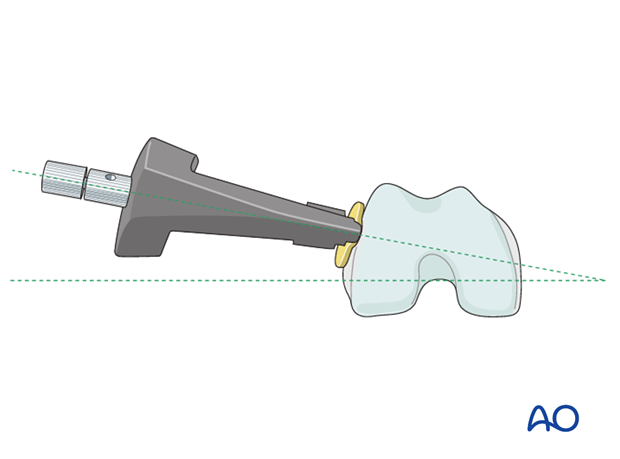
7. Preliminary plate fixation
From the AP perspective, a 280 mm long guide wire is inserted through the fixation bolt in hole “A” and should be parallel to the plane of the tibiofemoral joint (green dashed line). At that point, the pre-shaped LISS plate is in the correct position, assuming normal anatomy. This helps to restore correct alignment in complex fracture patterns.
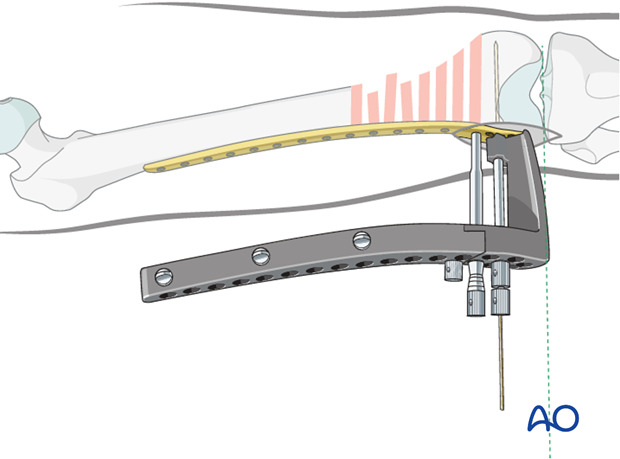
Stab incision
Make a stab incision over the most proximal screw hole of the LISS plate and dissect bluntly down to it.
Insert an insertion sleeve with a 5 mm trocar through the appropriate hole (5, 9, or 13) in the insertion guide and down to the proximal LISS plate hole.
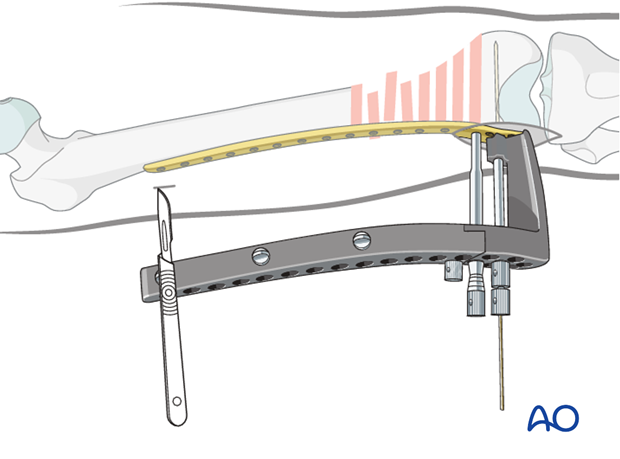
Insertion of the proximal stabilization bolt
Remove the trocar from the insertion sleeve.
Insert a stabilization bolt through the insertion sleeve and into the LISS plate. This creates a fixed parallelogram that facilitates further manipulation of the LISS plate.
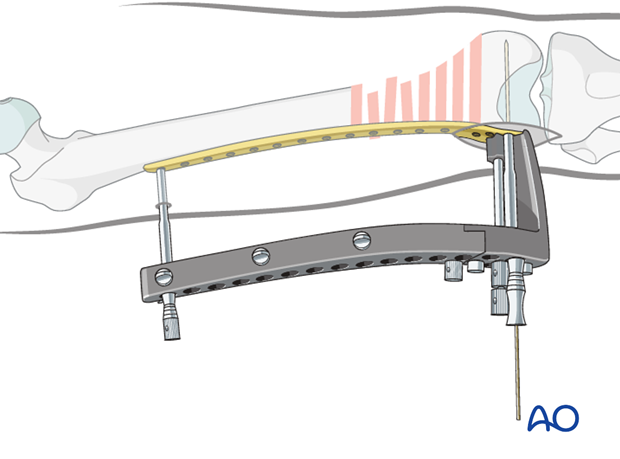
Proximal plate position
It is very important to confirm the correct LISS plate position proximally. In the minimal invasive technique, this can be challenging. Even the use of an image intensifier does not guarantee an optimal position.
To overcome this problem, the proximal incision is enlarged and the correct LISS plate position is controlled directly with the index finger, using the insertion guide to alter the plate position.
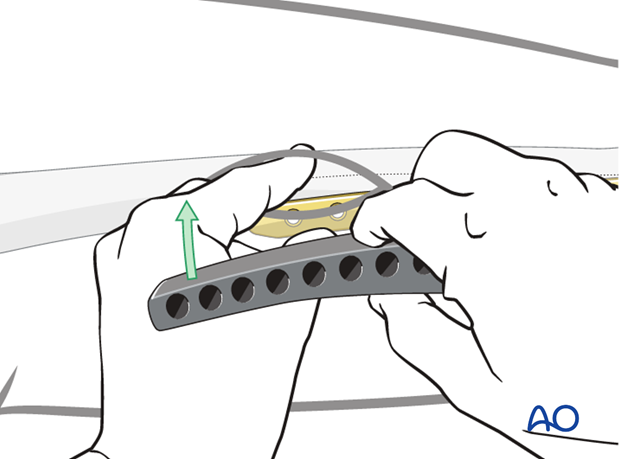
Proximal guide-wire insertion
After the proper length and rotation are assured, and the appropriate positioning of the proximal portion of the LISS plate on the midlateral aspect of the femur has been established, a proximal guidewire is inserted through the stabilization bolt.
It is extremely important to establish the correct placement of the guidewire in order to ensure proper proximal insertion of the monocortical locking-head screws.
It is still possible at this point to correct the sagittal plane alignment, as noted below. Small corrections of the adduction of the proximal fragment, or of the varus/valgus alignment of the distal femoral condyle, are possible.
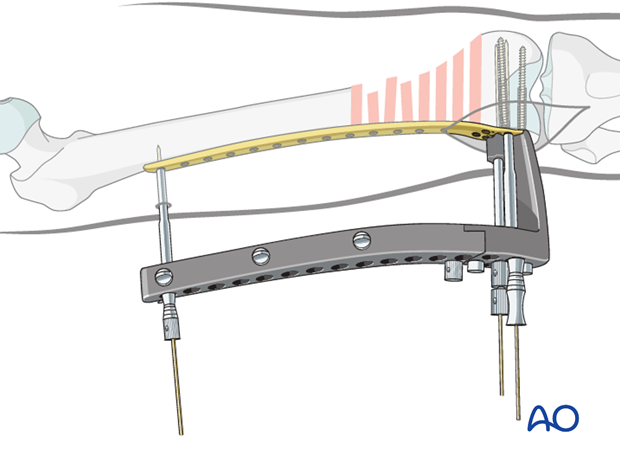
8. Distal plate fixation
Length of screws
Determine the appropriate screw length by using a 280 mm long guide wire that has been passed through the fixation bolt in hole “A” and an indirect measuring device, or according to the preoperative plan.
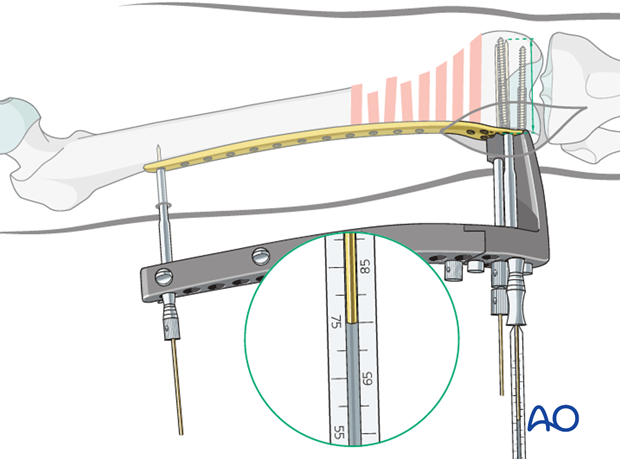
Screw insertion
Insert a minimum of four 5.0 mm locking screws into the LISS plate through the insertion sleeves, which are passed through the insertion guide.
For the final locking of the screws, the use of the torque-limited screwdriver is necessary.
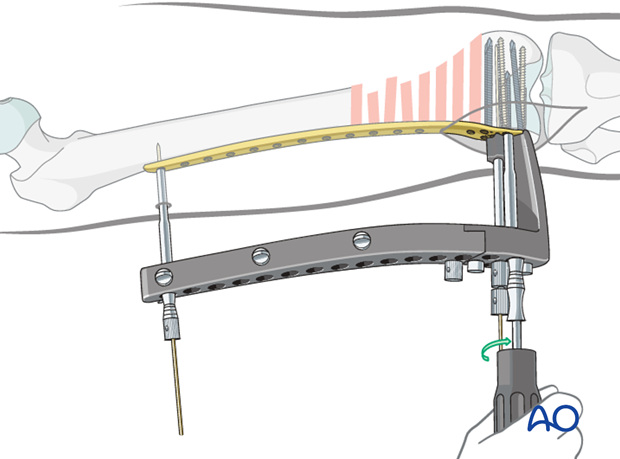
9. Securing the proximal fragment
Reduction of the proximal femoral shaft with the pull reduction instrument
With the help of the pull reduction instrument, secure the desired position of the shaft, in relation to the LISS plate. This is an important step because otherwise some displacement may occur during the insertion of self-drilling/self-tapping screws.
Attach a syringe, filled with saline, to the drill sleeve to provide cooling during the bone drilling procedure.
The pull reduction instrument is self drilling and self tapping. It is inserted through a sleeve that has been placed in the appropriate hole in the insertion guide and has been advanced through a stab incision. The pull reduction instrument is inserted using a power tool but great care is needed, using an image intensifier, only to engage the threaded portion into the bone. Over-insertion will strip its thread in the bone.
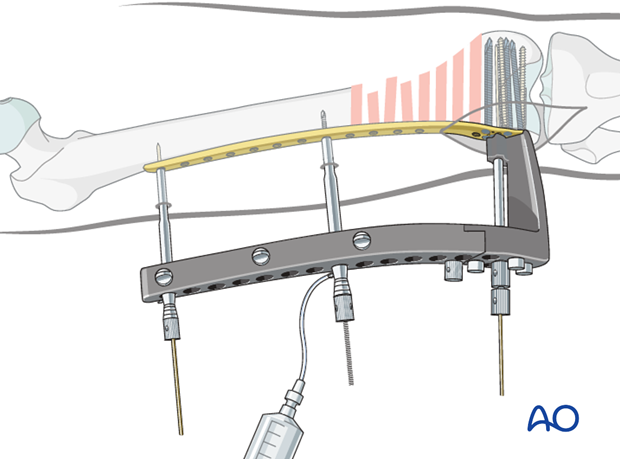
The nut of the pull instrument is then tightened against the head of the insertion sleeve, and tightening continued until the bone has been drawn into the required position of reduction against the LISS plate.

10. Additional screw insertion
Insert additional locking-head screws (LHS) both proximally and distally. In general, a total of four dispersed proximal and four distal LHS are placed.
Bicortical self-tapping LHS can be used for shaft fixation in severe osteoporosis.
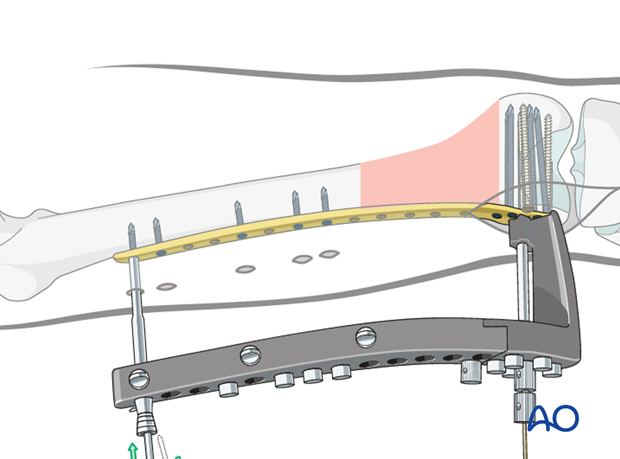
After detachment of the insertion guide, insert a final screw into the distal fragment through the central hole in the distal portion of the plate (“A”).

11. Wound closure
Close the iliotibial band using absorbable sutures. Close the skin and subcutaneous tissue in the routine manner.
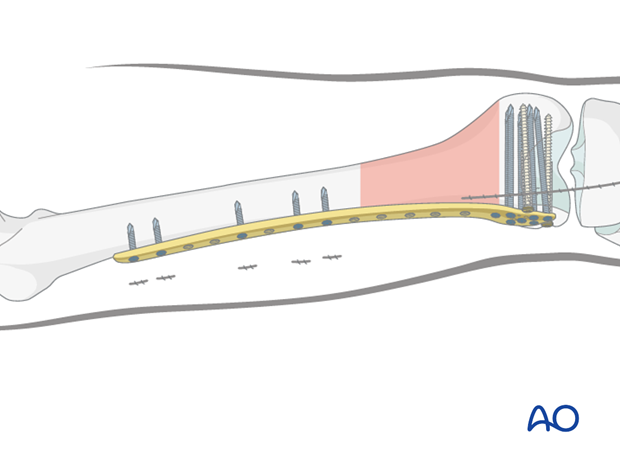
12. Case
Preoperative image showing a transverse distal femoral fracture in a 90-year-old osteoporotic patient.
The principles shown for bridge plating of this simple transverse fracture can also be applied for extraarticular wedge and fragmentary fractures as well.
Most simple fractures are treated with compression and lag screws. However, because of the quality of bone as well as a slight valgus compression, this case was treated with a bridge plate.

Note the support under the distal femur to facilitate fluoroscopy and reduction.
The principle of MIPO is to use small proximal and distal incisions, leaving the fracture zone untouched.
This image demonstrates marking of the planned position of the implant on the lateral thigh. This careful pre-incision planning ensures that the incisions will be in the right place.
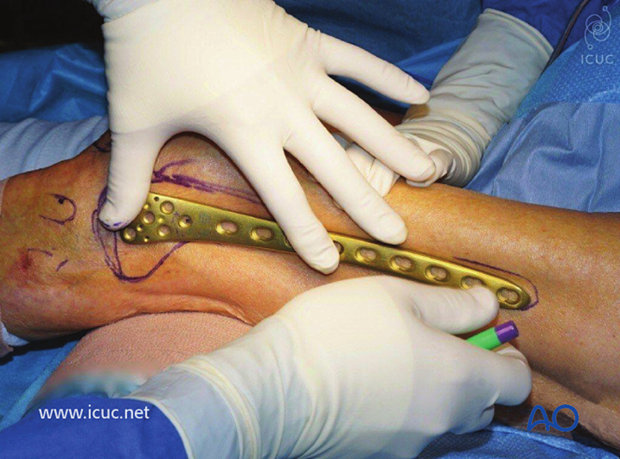
The incisions are made in the line of the femur. The distal incision must be large enough to insert the plate and distal screws, and usually allows the distal femoral articular joint line to be seen.
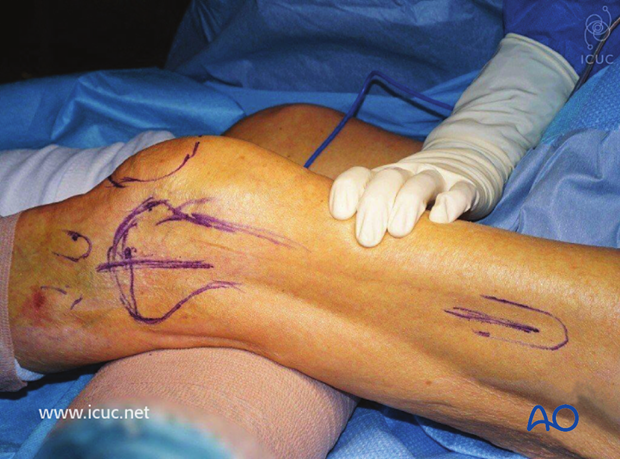
A sub vastus tunnel is created, and the plate is introduced from distal to proximal. The plate must then be carefully seated in the correct position on the distal femur.
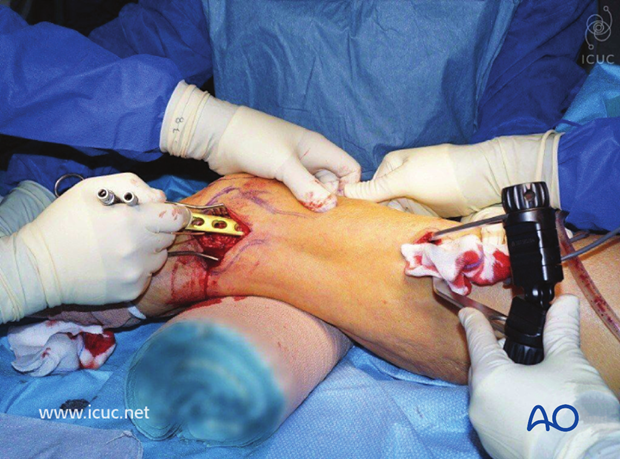
Note, the plate is too proximal in this image and the fracture is still in valgus.
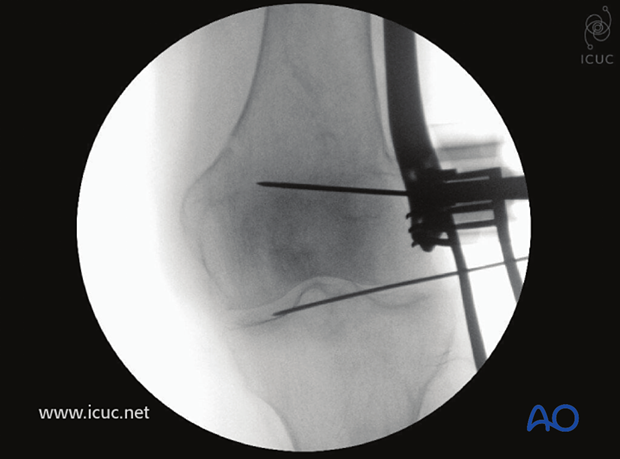
The plate has been moved a few mm distally so that it now fits the distal femur. At this point the fracture would usually be reduced to correct the valgus deformity.
In this case, given the limited functional requirement and as the fracture was relatively stable in its impacted position, the decision was made to accept the deformity.
The guide wire in the joint, shows the plane of the joint. If the fracture had been disimpacted to correct the alignment, the guide wire through the plate should be parallel to the guide wire in the joint.
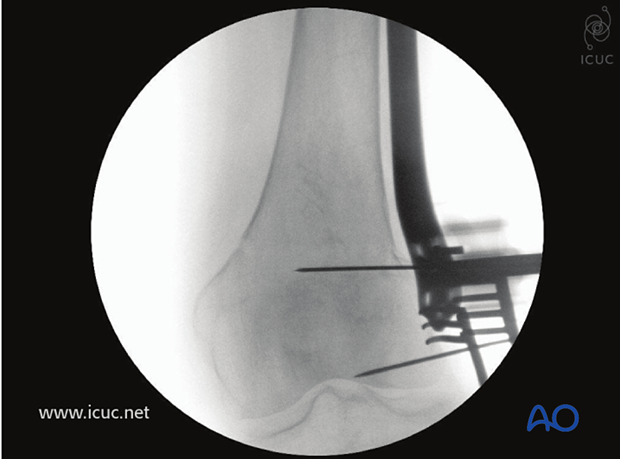
This image shows the top of the plate being placed on the femoral shaft. The correct placement should be checked with a lateral X-ray.
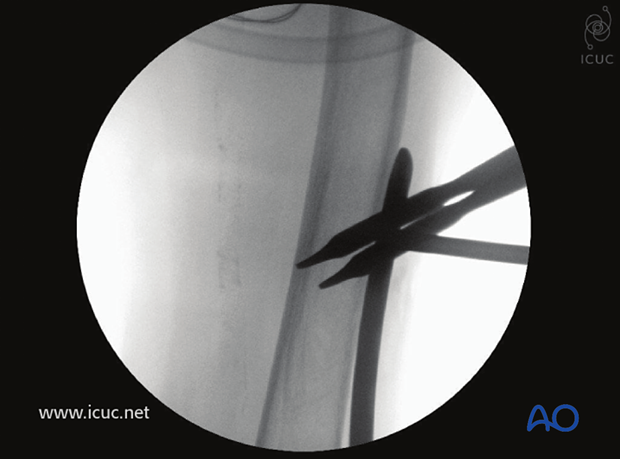
The implant is now in place ready to start screw insertion.
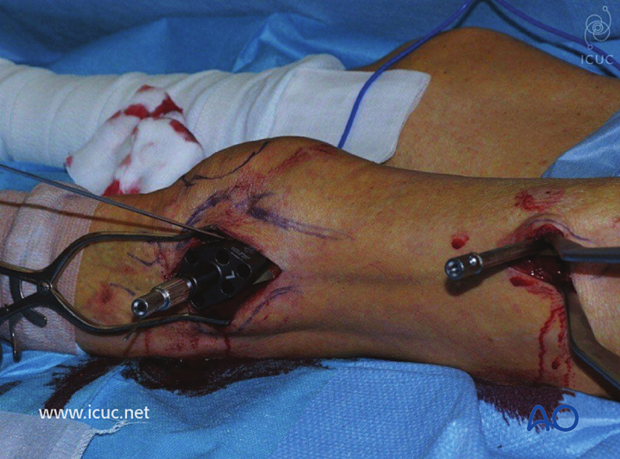
This image shows correct placement of the LISS plate in the sagittal plane.
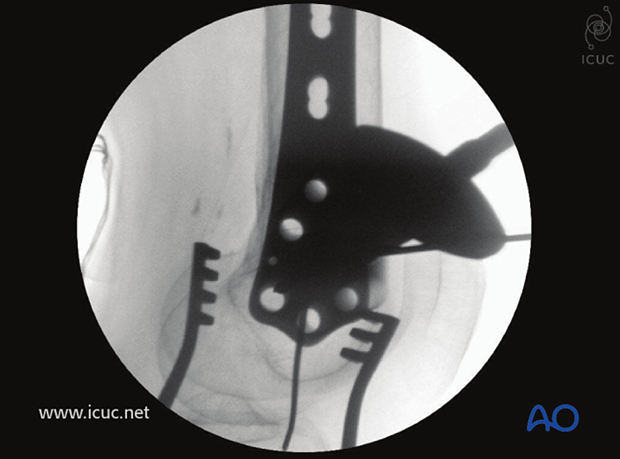
This image shows that the screws are not parallel to the distal femoral joint line. In this case the surgeon felt that this was the best acceptable position because a revision surgery may leave no bone to work with.
When this fracture heals will have a very mild valgus deformity.
In a young patient this deformity should not be accepted.
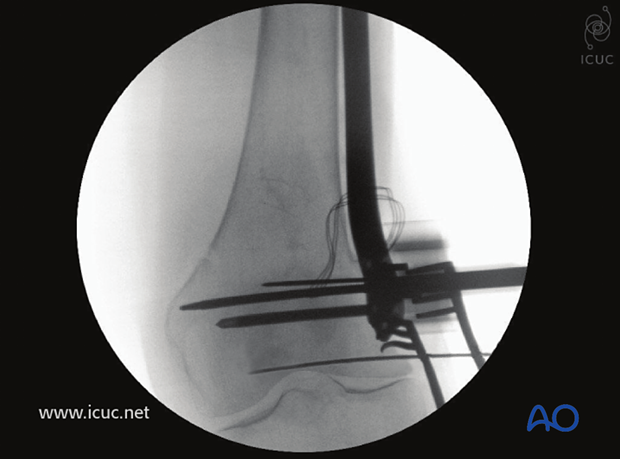
Clinical image of distal femur with multiple screws placed through a very small incision.

This image shows the plate has been secured to the bone with a drill bit through one hole while a second hole is drilled to insert the first proximal screw through the small subvastus MIPO incision.
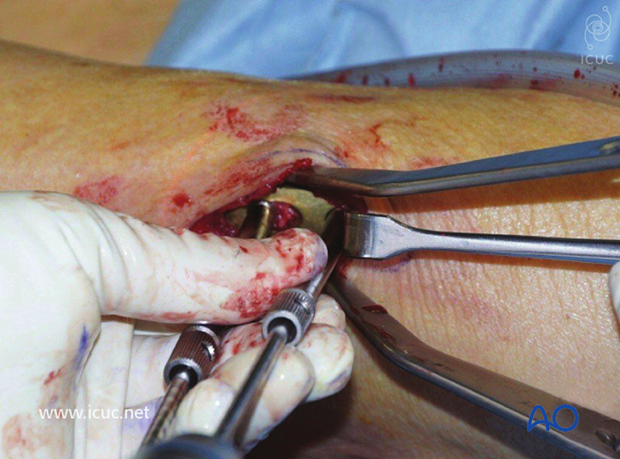
Final AP image with multiple screws inserted to obtain secure hold of the distal femoral fragment.
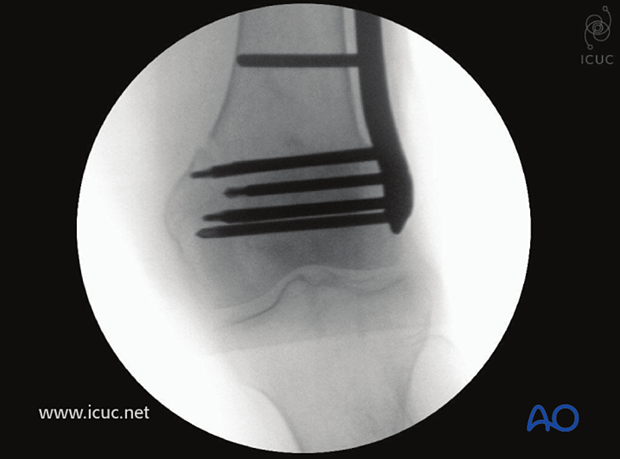
This shows the principle of placing screws in a near/far position in the plate. Distal fixation is secure. One further screw was inserted through a stab incision to obtain sufficient fixation of the plate to the shaft.
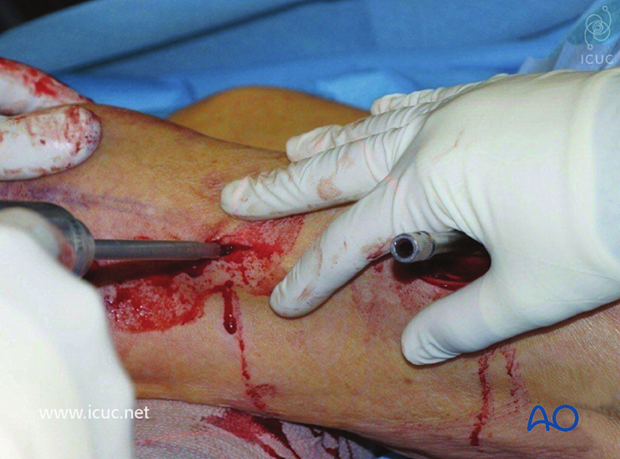

At the end of the procedure, stable fixation is confirmed.
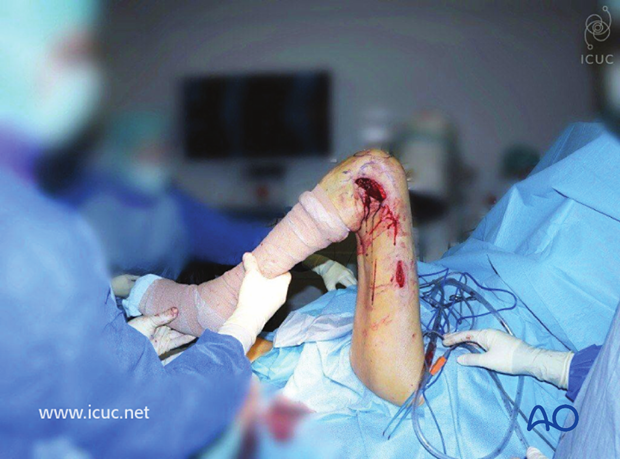
The tensor fascia lata is closed over the plate.

Final clinical image after closure.
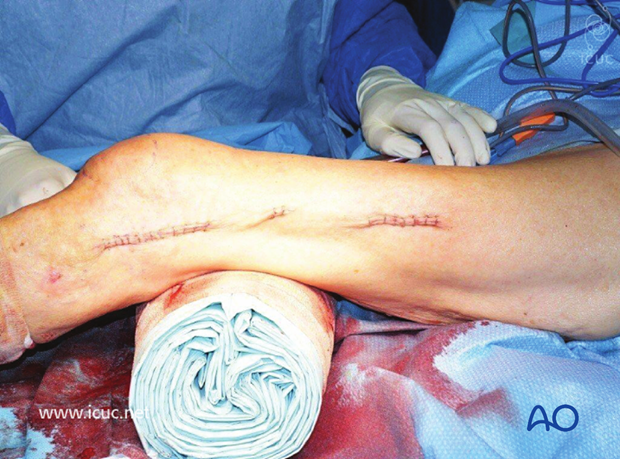
Postoperative images. The AP image shows secure fixation but slight persistent valgus.
On the lateral it can be seen that the distal end of the plate could have been placed a little more anteriorly, which would have resulted in the plate lying in the axis of the femoral shaft. This position is acceptable as the proximal screws still obtained secure fixation.
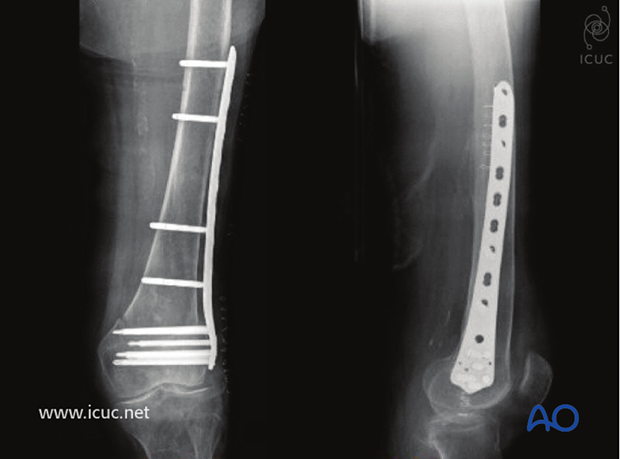
6 week images showing healing (the minor medial gap is gone)
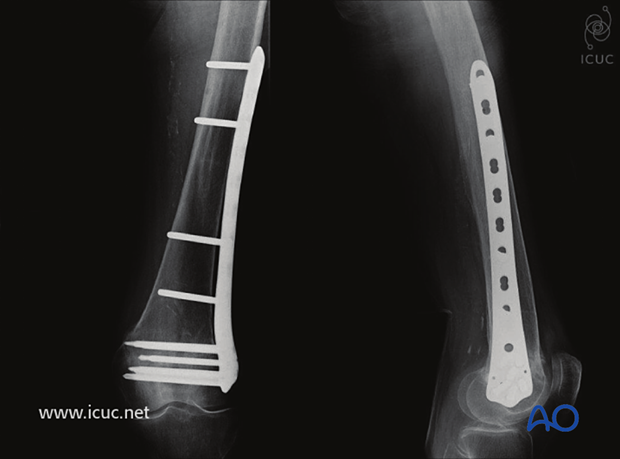
52 week images showing complete healing.
The screws in the distal femur are of the self-drilling type and are no longer used as they are thought to be too sharp. If they penetrate the far cortex they may cause soft tissue damage or irritation.
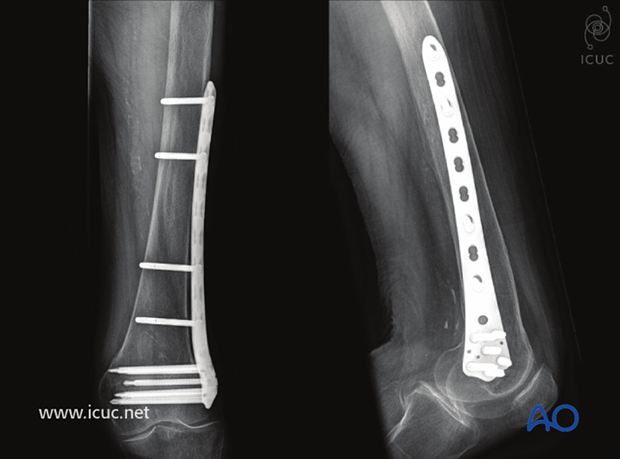
13. Aftercare
Impediments to the restoration of full knee function after distal femoral fracture are fibrosis and adhesion of injured soft tissues around the metaphyseal fracture zone, joint capsular scarring, intra-articular adhesions, and muscle weakness.
Early range of motion helps restore movement in the early postoperative phase. With stable fracture fixation, the surgeon and the physical therapy staff will design an individual program of progressive rehabilitation for each patient.
The regimens suggested here are for guidance only and not to be regarded as prescriptive.
Functional treatment
Unless there are other injuries or complications, knee mobilization may be started immediately postoperatively. Both active and passive motion of the knee and hip can be initiated immediately postoperatively. Emphasis should be placed on progressive quadriceps strengthening and straight leg raises. Static cycling without load, as well as firm passive range of motion exercises of the knee, allow the patient to regain optimal range of motion.
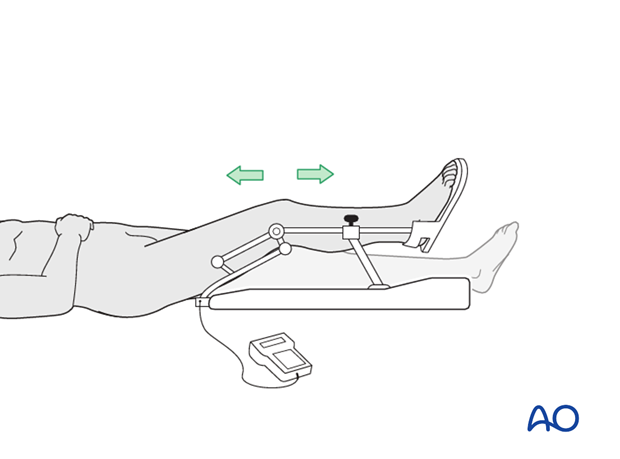
Weight bearing
Touch-down weight-bearing (10-15 kg) may be performed immediately with crutches, or a walker. This will be continued for 6-10 weeks postoperatively. This is mostly to protect the articular component of the injury, rather than the shaft injury. Touch-down weight-bearing progresses to full weight-bearing gradually, over a period of 2 to 3 weeks (beginning at 6–10 weeks postoperatively). Ideally, patients are fully weight-bearing, without devices (e.g., cane) by 12 weeks.
Follow-up
Wound healing should be assessed at two to three weeks postoperatively. Subsequently 6-week, 12-week, 6-month, and 12-month follow-ups are usually made. Serial x-rays allow the surgeon to assess the healing of the fracture.
Implant removal
Implant removal is not essential but should be discussed with the patient if there are implant-related symptoms after consolidated fracture healing.
Thrombo-embolic prophylaxis
Thrombo-prophylaxis should be given according to local treatment guidelines.













